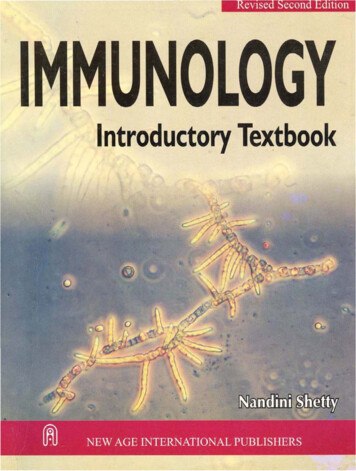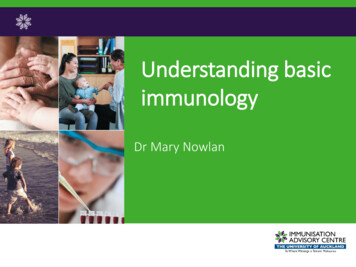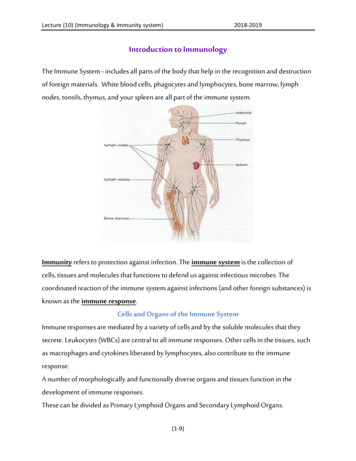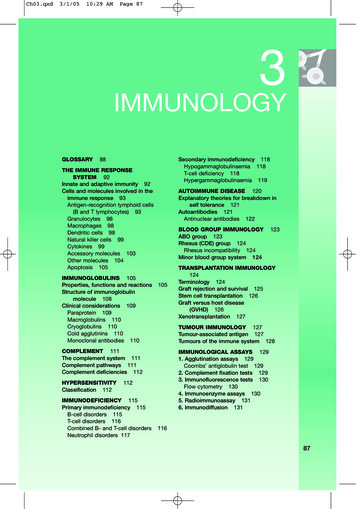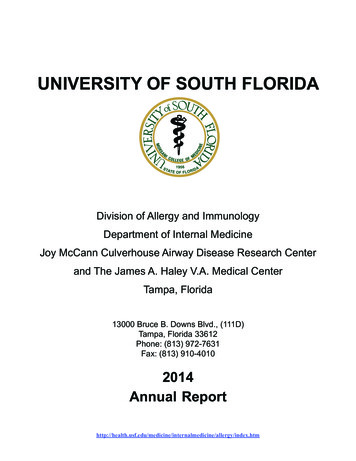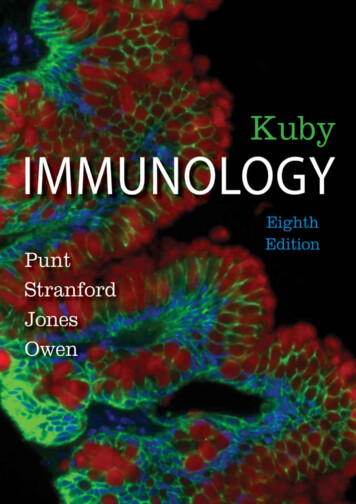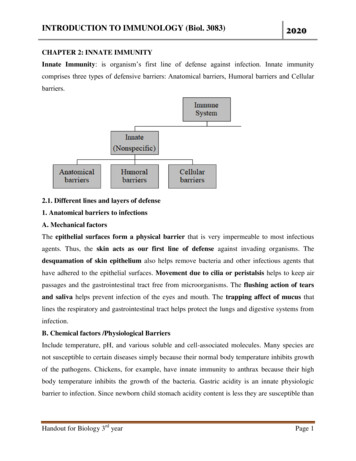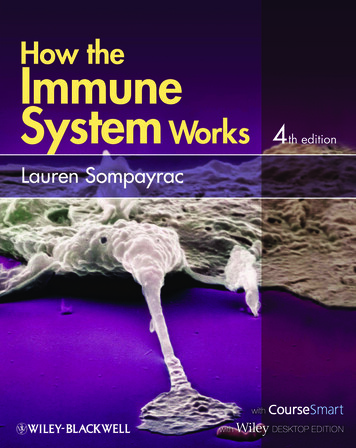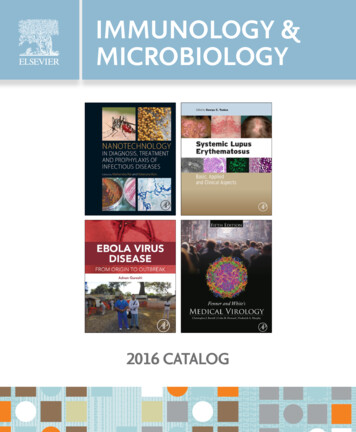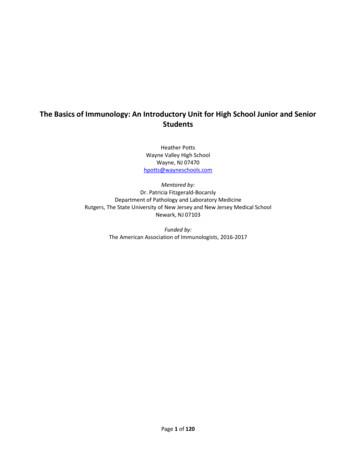
Transcription
The Basics of Immunology: An Introductory Unit for High School Junior and SeniorStudentsHeather PottsWayne Valley High SchoolWayne, NJ 07470hpotts@wayneschools.comMentored by:Dr. Patricia Fitzgerald-BocarslyDepartment of Pathology and Laboratory MedicineRutgers, The State University of New Jersey and New Jersey Medical SchoolNewark, NJ 07103Funded by:The American Association of Immunologists, 2016-2017Page 1 of 120
Teacher GuideTABLE OF CONTENTSI.Science Background - - - - - - - - - - - - - - - - - - - - - - - - - - - - - - - - - - - - - - - - - - - - - - - - - - - - - - - - - - - - - - - - - 4II.Student Outcomes - - - - - - - - - - - - - - - - - - - - - - - - - - - - - - - - - - - - - - - - - - - - - - - - - - - - - - - - - - - - - - - - - - 5a. Science Concepts Covered in the Unit - - - - - - - - - - - - - - - - - - - - - - - - - - - - - - - - - - - - - - - - - - - - - - - - 5b. Next Generation Science Standards (NGSS) - - - - - - - - - - - - - - - - - - - - - - - - - - - - - - - - - - - - - - - - - - - - 5c.Recommended Course Placement - - - - - - - - - - - - - - - - - - - - - - - - - - - - - - - - - - - - - - - - - - - - - - - - - - - 6d. Student Activities and Skills - - - - - - - - - - - - - - - - - - - - - - - - - - - - - - - - - - - - - - - - - - - - - - - - - - - - - - - - 6e. Relevance - - - - - - - - - - - - - - - - - - - - - - - - - - - - - - - - - - - - - - - - - - - - - - - - - - - - - - - - - - - - - - - - - - - - - 7III.Learning Objectives - - - - - - - - - - - - - - - - - - - - - - - - - - - - - - - - - - - - - - - - - - - - - - - - - - - - - - - - - - - - - - - - - 8IV.Time Requirements - - - - - - - - - - - - - - - - - - - - - - - - - - - - - - - - - - - - - - - - - - - - - - - - - - - - - - - - - - - - - - - - - 8V.Advance Preparation - - - - - - - - - - - - - - - - - - - - - - - - - - - - - - - - - - - - - - - - - - - - - - - - - - - - - - - - - - - - - - - - 8VI.Materials and Equipment - - - - - - - - - - - - - - - - - - - - - - - - - - - - - - - - - - - - - - - - - - - - - - - - - - - - - - - - - - - - - 9VII.Student Prior Knowledge and Skills - - - - - - - - - - - - - - - - - - - - - - - - - - - - - - - - - - - - - - - - - - - - - - - - - - - - - 9VIII.Daily Unit Plans - - - - - - - - - - - - - - - - - - - - - - - - - - - - - - - - - - - - - - - - - - - - - - - - - - - - - - - - - - - - - - - - - - - 10IX.Summative Assessment - - - - - - - - - - - - - - - - - - - - - - - - - - - - - - - - - - - - - - - - - - - - - - - - - - - - - - - - - - - - - 22a. QUIZ 1: Intro to Immunology (and key) - - - - - - - - - - - - - - - - - - - - - - - - - - - - - - - - - - - - - - - - - - - - - - -23b. QUIZ 2: Cells and Other Defenses (and key) - - - - - - - - - - - - - - - - - - - - - - - - - - - - - - - - - - - - - - - - - - - 27c.QUIZ 3: Innate Immunity and Inflammation (and key) - - - - - - - - - - - - - - - - - - - - - - - - - - - - - - - - - - - -33d. QUIZ 4: Adaptive Immunity (and key) - - - - - - - - - - - - - - - - - - - - - - - - - - - - - - - - - - - - - - - - - - - - - - - - 37e. QUIZ 5: Humoral and Cell Mediated Specifics (and key) - - - - - - - - - - - - - - - - - - - - - - - - - - - - - - - - - - -41X.Teacher Answer Keys - - - - - - - - - - - - - - - - - - - - - - - - - - - - - - - - - - - - - - - - - - - - - - - - - - - - - - - - - - - - - - - 49a. Khan Academy Ed Puzzle - - - - - - - - - - - - - - - - - - - - - - - - - - - - - - - - - - - - - - - - - - - - - - - - - - - - - - - - - 50b. Immunology Game Review Rubric - - - - - - - - - - - - - - - - - - - - - - - - - - - - - - - - - - - - - - - - - - - - - - - - - - 54c.Immune System Quiz 1 Review - - - - - - - - - - - - - - - - - - - - - - - - - - - - - - - - - - - - - - - - - - - - - - - - - - - - -55d. Immune Cells ID WS - - - - - - - - - - - - - - - - - - - - - - - - - - - - - - - - - - - - - - - - - - - - - - - - - - - - - - - - - - - - -58e. Immune System Quiz 2 Review - - - - - - - - - - - - - - - - - - - - - - - - - - - - - - - - - - - - - - - - - - - - - - - - - - - - -60f.Innate Immunity Review - - - - - - - - - - - - - - - - - - - - - - - - - - - - - - - - - - - - - - - - - - - - - - - - - - - - - - - - - -63g. Inflammation WebQuest - - - - - - - - - - - - - - - - - - - - - - - - - - - - - - - - - - - - - - - - - - - - - - - - - - - - - - - - - 67h. Overview of the Adaptive Immune System Review - - - - - - - - - - - - - - - - - - - - - - - - - - - - - - - - - - - - - - 69i.Adaptive Immunity Flow Charts - - - - - - - - - - - - - - - - - - - - - - - - - - - - - - - - - - - - - - - - - - - - - - - - - - - - 71j.Create Your Own Antibodies! - - - - - - - - - - - - - - - - - - - - - - - - - - - - - - - - - - - - - - - - - - - - - - - - - - - - - -75k. Humoral and Cell-Mediated Flow Charts - - - - - - - - - - - - - - - - - - - - - - - - - - - - - - - - - - - - - - - - - - - - - -76l.AIDS Simutest - - - - - - - - - - - - - - - - - - - - - - - - - - - - - - - - - - - - - - - - - - - - - - - - - - - - - - - - - - - - - - - - - 80Page 2 of 120
Student SectionI.Rationale - - - - - - - - - - - - - - - - - - - - - - - - - - - - - - - - - - - - - - - - - - - - - - - - - - - - - - - - - - - - - - - - - - - - - - - - 82II.Materials - - - - - - - - - - - - - - - - - - - - - - - - - - - - - - - - - - - - - - - - - - - - - - - - - - - - - - - - - - - - - - - - - - - - - - - - 82a. Flow charts: Student handout, test resource, and modified test resource - - - - - - - - - - - - - - - - - - - - - 83b. Note packet* - - - - - - - - - - - - - - - - - - - - - - - - - - - - - - - - - - - - - - - - - - - - - - - - - - - - - - - See separate filec.Immunology Game Review directions sheet - - - - - - - - - - - - - - - - - - - - - - - - - - - - - - - - - - - - - - - - - - - 86d. Immune System Quiz 1 Review - - - - - - - - - - - - - - - - - - - - - - - - - - - - - - - - - - - - - - - - - - - - - - - - - - - - -88e. Immune Cells ID WS - - - - - - - - - - - - - - - - - - - - - - - - - - - - - - - - - - - - - - - - - - - - - - - - - - - - - - - - - - - - -91f.Immune System Quiz 2 Review - - - - - - - - - - - - - - - - - - - - - - - - - - - - - - - - - - - - - - - - - - - - - - - - - - - - -93g. Innate Immunity Review - - - - - - - - - - - - - - - - - - - - - - - - - - - - - - - - - - - - - - - - - - - - - - - - - - - - - - - - - -96h. Inflammation WebQuest - - - - - - - - - - - - - - - - - - - - - - - - - - - - - - - - - - - - - - - - - - - - - - - - - - - - - - - - 100i.Overview of the Adaptive Immune System Review - - - - - - - - - - - - - - - - - - - - - - - - - - - - - - - - - - - - - 102j.Adaptive Immunity Flow Charts - - - - - - - - - - - - - - - - - - - - - - - - - - - - - - - - - - - - - - - - - - - - - - - - - - - 104k. Create Your Own Antibodies! - - - - - - - - - - - - - - - - - - - - - - - - - - - - - - - - - - - - - - - - - - - - - - - - - - - - - 108l.Humoral and Cell-Mediated Flow Charts - - - - - - - - - - - - - - - - - - - - - - - - - - - - - - - - - - - - - - - - - - - - -110m. AIDS Simutest - - - - - - - - - - - - - - - - - - - - - - - - - - - - - - - - - - - - - - - - - - - - - - - - - - - - - - - - - - - - - - - - -114III.Procedure - - - - - - - - - - - - - - - - - - - - - - - - - - - - - - - - - - - - - - - - - - - - - - - - - - - - - - - - - - - - - - - - - - - - - - -120IV.Data Collection - - - - - - - - - - - - - - - - - - - - - - - - - - - - - - - - - - - - - - - - - - - - - - - - - - - - - - - - - - - - - - - - - - -120V.Discussion/Analysis - - - - - - - - - - - - - - - - - - - - - - - - - - - - - - - - - - - - - - - - - - - - - - - - - - - - - - - - - - - - - - - -120Page 3 of 120
Science BackgroundTeacher GuideTechnology and increased travel ability have resulted in the increased mobility of diseases that would normally beisolated in one area. Understanding how different diseases affect humans is therefore something that can provebeneficial to students, even at the high school level. My summer laboratory research experience through The AmericanAssociation of Immunologists High School Teachers Summer Research Program in Immunology provided me with anincreased understanding of functioning of specific immune cells. The research focused on the metabolic responses ofcertain cells when exposed to different types of viruses, and inspired me to create a curriculum for high school studentswhich would introduce them to parts of the immune system and how they will react and interact as a result ofexposure to disease.The unit that I created focused on discussion, lecture, and review to introduce complex topics to high school junior andsenior students. I took the opportunity not just to teach the students concepts of immunology, but to also introducestudents to different ways to organize and approach difficult material in order to better prepare them for futureacademic challenges. Students performed WebQuest assignments and completed paper-based labs in order tofamiliarize themselves with the various parts of the immune response. The unit ended with students learning aboutscreening for HIV using an enzyme-linked immunosorbent assay (ELISA) simulation. The goal of the unit is to not onlyprovide students with basic knowledge of the functioning of the immune system, but to also introduce them to specificimmune responses for different types of stimulation of immune response as well as how diseases are tested for in themedical community, as well as prepare them for future science classes.I used many resources in order to put together the information that was then presented to the students. Please seethe concepts listed in the “Student Outcomes” section for a more complete and detailed list of topics. See below forthe specific resources used to supplement my knowledge.Resources/References Used to Prepare Unit: Lodish, Harvey., et. al. (2016). Chapter 23: Immunology. In Molecular Cell Biology 8th ed. (pp. 1079-1133).New York, NY: W.H. Freeman and Company. ooISBN-13: 978-1464183393ISBN-10: 1464183392ooISBN-13: 978-0815342434ISBN-10: 0815342438Murphy, Kenneth. (2012). Chapter 1: Basics Concepts in Immunology. In Janeway’s Immunobiology 8th ed. (pp.1-36). London and New York: Garland Science.Bauman, Robert W. (2012). Chapters 15-18: Innate Immunity, Adaptive Immunity, Immunization and ImmuneTesting, AIDS and Other Immune Disorders. In Microbiology with Diseases By Body System 3rd ed. (pp.445554). Boston: Benjamin Cummings.oo ISBN-13: 978-0321712714ISBN-10: 0321712714Dr. P. Fitzgerald-Bocarsly immunology lecture notes (personal communication), August 1-28 2016.Page 4 of 120
Student OutcomesScience Concepts Covered in the Unit(Note: please see the additional, attached power point presentation for more)1. (Intro) Parts of the immune system Innate vs. adaptive immunity Organs Cells Other aspects of the immune system2. Functioning of the innate immune system Elements of the first line of defense Functioning of the second line of defense (outlined in the flow chart seen in the power point)1. Cells2. Opsonization3. Cytokines4. Complement5. Inflammation3. Functioning of the adaptive immune system Introduction and overview of adaptive immunity1. Characteristics of adaptive immunity2. Cell functions (basics of B and T cells)3. Formation of B and T cells4. The MHC Humoral immunity How B cells function Cell mediated immunity T cell types and functioning How the cells work together for an adaptive immune response (another flow chart created by me tosummarize the adaptive immunity section)4. Vaccines, Diseases of the Immune System Vaccines1. Types of immunity2. Types of vaccines3. Vaccine safety and herd immunity4. CDC recommendations Disease of the immune system1. Hypersensitivities2. Graft rejection and graft vs. host disease3. Autoimmunity4. Primary and secondary immunodeficiency diseases Focus on AIDS, but will also discuss other diseases/disordersNext Generation Science Standards (NGSS)HS-LS1 From Molecules to Organisms: Structures and Processes1. HS-LS1-2 Develop and use a model to illustrate the hierarchical organization of interacting systems thatprovide specific functions within multicellular organisms.a. [Clarification Statement: Emphasis is on functions at the organism system level such as nutrientuptake, water delivery, and organism movement in response to neural stimuli. An example of aninteracting system could be an artery depending on the proper function of elastic tissue and smoothmuscle to regulate and deliver the proper amount of blood within the circulatory system.] [AssessmentBoundary: Assessment does not include interactions and functions at the molecular or chemicalreaction level.]Page 5 of 120
2. Science and Engineering Practicesa. Developing and Using Models: Modeling in 9–12 builds on K–8 experiences and progresses to using,synthesizing, and developing models to predict and show relationships among variables betweensystems and their components in the natural and designed worlds.i. Develop and use a model based on evidence to illustrate the relationships between systemsor between components of a system. (HS-LS1-2)3. Disciplinary Core Ideasa. LS1.A: Structure and Functioni. Systems of specialized cells within organisms help them perform the essential functions of life.(HS-LS1-1)ii. Multicellular organisms have a hierarchical structural organization, in which any one system ismade up of numerous parts and is itself a component of the next level. (HS-LS1-2)4. Cross-Cutting Conceptsa. Systems and System Modelsi. Models (e.g., physical, mathematical, computer models) can be used to simulate systems andinteractions—including energy, matter, and information flows—within and between systemsat different scales. (HS-LS1-2)Recommended Course PlacementThis unit is intended for high school junior and senior students who have already had a biology class. It can be adaptedfor various levels of student. Due to its length, it is recommended that this unit be placed into a high school electiveclass where applicable (such as Anatomy and Physiology, Health, or other relevant elective depending upon what isoffered in the school). It may be used either in an AP Biology class or as a supplement to material covered in APBiology.Student Activities and SkillsNote alignment with previous section: Science Concepts Covered in Unit1. (Intro) Parts of the immune system Students will fill in note packet during lecture of this section Notes will be taken during class lecture Flow chart (my creation) that will be filled out in class of the overview of the immune system Introduction to immunology using a Khan Academy video and EdPuzzle Students will also have access to Khan Academy videos and my notes/outlines which they willuse as an introduction to the immune system and its functioning Review material on: Introduction to the immune system Specific functioning of cells of the immune system Quizzes on topics discussed Quiz 1: Immunology Introduction Format Fill in the blank, true/false, short answer Quiz 2: Cells and Chemicals of the Immune System Format Fill in the blank, multiple choice, matching, short answer2. Functioning of the innate immune system Students will fill in note packet during lecture of this section Notes will be taken after class lecture Review material on: Components of innate immunity InflammationPage 6 of 120
Khan Academy video and question worksheet Question worksheet created by me to go along with the video and to function as review ofinflammation Quiz on topics discussed Quiz 3: Innate Immunity and Inflammation Short answer, fill in the blank, matching3. Functioning of the adaptive immune system Students will highlight provided notes during lecture of this section Students choose what to highlight based on discussion Additional notes added in along margins during discussion Review materials: Flow chart: Overview of Adaptive Immunity (created by me) Flow chart: Humoral Immunity (created by me) Flow chart: Cell-mediated Immunity (created by me) Antibody Function—Student Activity Kit From Flinn Scientific (link above) Activity designed to introduce students to idea of antibody specificity. Introduces variableand constant regions and matches specific antibodies with specific antigens for binding Quizzes on topics discussed Quiz 4: Overview of Adaptive immunity Short answer and fill in the blank, based on the review flow chart Quiz 5: Specifics of B and T cells Multiple choice, labeling, and short answer4. Vaccines, Diseases of the Immune System Students will highlight provided notes during lecture of this section Students provided what to highlight in lecture notes (intention is to confirm how theyhighlighted things previously) Additional notes added in along margins during discussion AIDS Simutest Kit Includes pipette training This is an activity that will have students following ELISA procedure to screen various“patients” for HIV infection. Follow up questions about procedure and how it relates to what we have learned will be doneby students as assessment of this activityRelevanceThis unit is designed to be relevant to students both in terms of the material covered as well as how it is covered. Thematerial, immunology, is relevant to students so they understand how the body protects them from disease. The unitdelves deeply into material to prepare students for further study in the sciences and to expose them to intricatematerial that they may be experiencing in their future studies (after high school). It is also relevant as brief lesson onhow the immune system functions in conjunction with vaccines to develop memory and understanding of vaccinebenefit and safety. How the material is presented exposes students to different ways that they will be expected tolearn material after high school, helping them to develop skills for success in science lectures in the future.Page 7 of 120
Learning ObjectivesStudents will be able to: Differentiate between innate and adaptive immunityDescribe the different organs that are used for various functions as part of the immune responseList the main functions of each of the cells of the innate and adaptive immune responseDescribe how other elements of immunity (such as cytokines, surface receptors, and complement) relate to thefunctioning of the immune system and its partsDescribe the four features of inflammation and how they occurSummarize the steps and functioning of cells during an acute inflammatory responseDifferentiate between B and T cell functioning, including the different types of T cells (helper, cytotoxic, andregulatory)Describe how B and T cells are formed through clonal deletion and clonal expansionPerform a randomized antibody construction activity to illustrate the formation of specific antibody moleculesExplain the purpose of both MHC class I and MHC class II and how they relate to T cell functioningJustify how and why B and T cells need to work together for an effective immune response that does not attackselfSummarize the effects of helper T cells on other functions of adaptive immunityRelate the functioning of cytotoxic T cells to NK cellsDescribe different types of vaccines and their benefits and drawbacksExplain the definition and purpose of herd immunityDescribe hypersensitivities, graft rejection, GvHD, and various autoimmune diseasesDifferentiate between primary and secondary immunodeficiency diseasesPredict the negative impact of deficiencies of various parts of the immune system seen in primaryimmunodeficiency disordersPerform an ELISA to determine patients who are positive for simulated HIVTime RequirementsThe daily plans are designed around 42 minute periods, but may be adapted as needed. The ELISA simulation requires60 minutes to perform. I did this after school but have designed the unit plan provided here for 42 minute periods.Time requirements for each lesson are found in the daily plans. This unit is designed to take 40 full class days tocomplete, but portions are subdivided and may be removed as you see fit.Advance Preparation1. Photocopies of each of the following for all students, except where noted (a * indicates that I made that fileavailable for the students online rather than photocopying it):a. Student flow chart – blankb. Student flow chart – filled in (this is only a class set intended for use on quizzes)c. Note packetd. Immune System Quiz 1 Reviewe. QUIZ 1: Intro to Immunologyf. Immune Cells ID WSg. Immune System Quiz 2 Reviewh. QUIZ 2: Cells and Other Defensesi. Innate Immunity ReviewPage 8 of 120
j. Inflammation WebQuest*k. QUIZ 3: Innate Immunity and Inflammationl. Overview of the Adaptive Immune System Reviewm. Adaptive Immunity flow chartsn. QUIZ 4: Adaptive Immunityo. Create Your Own Antibodies! (Activity)p. Humoral and Cell-Mediated flow chartsq. QUIZ 5: Humoral and Cell-Mediated Specificsr. AIDS Simutest (Lab)2. Khan Academy EdPuzzlea. Use provided guide to create an EdPuzzle at www.edpuzzle.com for students to complete3. Create Your Own Antibodies!a. Photocopy an antibody for each student from the kitb. Photocopy several pages of the antigens (you do not need one for each student as there are 8 antigenson each sheet)c. Set up paper, scissors, and multiple rolls of tape for students to use when cutting out the pieces4. AIDS Simutesta. Organize the samples, chromogen, and conjugate vials so groups have easy accessb. You may want to label the plates the students will be running the tests in so that you can save time onday of the labMaterials and Equipment1. Paper for student copies2. Computers with Internet accessa. We had access to Chromebooks for student use, allowing 1:1 use of technology, but students maywork in groups on the assignmentsb. Approximate cost 10,000.00 for a charging cart and 30 Chromebooksc. Possible alternatives include:i. Use of a computer lab on days that you will need computer accessii. Allowing students to use personal devices, such as their own laptops or their cell phones3. Create Your Own Antibodies!a. Antibody Function – Student Laboratory Kit from Flinn Scientific (item #FB1967)b. Cost 18.60 per class setc. The kit was used as a base to create the paper activity. You may use the lab directly or make thephotocopies as suggested above.4. AIDS Simutesta. AIDS Simutest Kit from Carolina Biological (item #700472)b. Cost 136.95 per class setStudent Prior Knowledge and SkillsStudents should be knowledgeable about basic cell structure and function. Students should have a basic knowledge ofthe systems of the body, but a previous anatomy and physiology course is not required. Finally, students need anunderstanding of different types of pathogens (bacteria, viruses, fungi, parasitic worms, and protozoans). Thisunderstanding should include basic characteristics as well as life cycles and how these organisms can cause disease.Page 9 of 120
Daily Unit PlansBelow are the daily plans for this unit. Note the length of time. Due to the intense nature of this material, studentswere instructed to be reviewing daily, so even if there was no assigned homework for the night the expectation wasset. For reference materials, please see the list in Section I: Science Background. Note that material often pulled fromall of the references listed there, and did not directly come from just one of those resources at a time.DAY 1: Introduction to ImmunologyMaterials: Procedure:1. Students will complete a created EdPuzzle on an overview of the immune system.2. EdPuzzle works by adding students into the class and having them answer questions during a video(which can be selected through the EdPuzzle website). EdPuzzle will then grade the student’sanswers and provide results to you the teacher.a. Students may rewind portions of the video as needed to help them with the assignedquestions, but cannot go back to questions once they have answered them.3. As students watch the video, they should also be recreating the flow chart that is being drawn bythe instructor on the video.a. Students are instructed to color code the information similarly to how it is beinggrouped by different colors in the videoHomework:NoneComputers for student useCreate the EdPuzzle as shown in provided documentsDAY 2: Introduction to ImmunologyMaterials: Procedure:1. Begin discussion on the immune system (hand out note packet). Start by discussing what studentsalready know about the immune system. From previous knowledge, they should be able to statethat white blood cells are part of the immune response, and that they will respond to pathogensthat enter the body (such as bacteria, viruses, etc.).2. Discuss the four features of immunity, focusing more time on the antibody and its structure andfunction in relation to specificity in recognizing antigens.3. Hand out the flow chart to students. The animated flow chart starts with the first line of defenseand continues through innate and adaptive immunity. Expand on each of the items as they comeup in the power point, discussing the notes that are added on as well as other material that youlearn/know about cells while preparing for this unit. Note that cells are in ovals, other processesand portions of the immune response are in cloud shapes. Arrows indicate interaction, and acircular arrow indicates proliferation.4. Continue discussion, moving to the three lines of defense.a. For the first line of defense, discuss that microbes will enter through openings,parasitic worms can burrow in, and fungi may digest exterior cells to gain entry.b. For innate and adaptive immunity, focus on the differences between the two,comparing and contrasting in relation to speed of action as well as specificity. Usethis time to use the flow chart that was filled out in order to expand on material thatyou will be coming back to throughout the unit.5. End discussion with how innate and adaptive immunity will work together and inform each other.Do not get into detail yet, just introduce the idea that they help each other out.Homework:ReviewPresentationNote packetStudent flow chart hand out (color copies, if possible)Page 10 of 120
DAY 3: Game Review PreparationMaterials: Procedure:1. Hand out and discuss the Immunology Game Review. Discuss possible topics that students canchoose from and assign groups.2. Have student groups choose topics and use what has been discussed as an overview to begindesigning their gameHomework:Create, as a group, a game proposalGame Review Instruction SheetDAY 4: Organs of the Immune SystemMaterials: Procedure:1. Continue introductory discussion by talking about the organs of the immune system, introducingit by explaining the role of the circulatory and lymphatic system. Discuss how these systems willcycle between each other.a. When discussing lymph nodes, this is a good time to talk about how cell division iswhat causes lymph nodes to enlarge when you are sick2. Finish the discussion with the critical thinking questiona. The cross-sectional area of the afferent lymphatic vessels arriving at a lymph node isgreater than the cross-sectional area of the efferent lymphatics exiting the lymphnode. The result is that lymph moves slowly through a lymph node. What advantagedoes this provide the body?b. Ans: Allows for antigen and cells to more effectively meet up if it is slow moving3. Hand out the quiz review. If there is time, allow students to begin work in class.Homework:Finish the quiz reviewPresentationImmune System Quiz 1 ReviewDAY 5: Cells of the Immune SystemMaterials: Procedure:1. Discuss answers to the quiz review2. Begin notes on cells of the immune system. Note that the notes during this section will startreferring to other parts of the presentation, this is for students to go back later and makeconnections. Discussion today will go through mast cells.a. Make sure to discuss hematopoietic stem cells in the bone marrow in relation to Tcells: recall that they are generated there but then will mature in the thymusb. The flow chart of hematopoiesis is adapted from an image found online (see link).Students are given this image in their note packet and it will be returned to at a laterdate for expansion.c. When discussing neutrophils, make sure to stress their important as phagocytesd. When discussing eosinophils, mention that allergies are thought to be because weare cleaner now and do not have parasitic worms that the eosinophils will normallyreact to. Relate eosinophils to basophils and mast cells (connect with allergies).Homework:Study for Quiz 1: Intro to ImmunologyPresentationPage 11 of 120
DAY 6: Cells of the Immune SystemMaterials: Procedure:1. Allow time for students to complete QUIZ 1: Intro to Immunology. Hand out printed flow chart foruse on the quiz as a resource. Re-collect with quiz when students are finished.2. Finish discussion on cells. Relate NK cells to cytotoxic T cell functioning. Discuss the different typesof T cells, but students aren’t required to know the information yet. When macrophages arediscussed, focus on phagocytosis and mention the importance of “tissue resident” macrophagesand their difference from circulating monocytes that will become macrophages. Focus on dendriticcells (name from dendrites like nerve cells, but not related to nervous system!) and theirimportance as antigen-presenting cells to bridge the innate and adaptive response. End thediscussion by discussing the importance of phagocytosis and antigen presentation.3. Hand out the Cells ID WS and allow students to begin if they have time. Note to the students thatmultiple answers may be applicable for some of the questions. If that is the case, they areexpected to list all the cells that are being described.Homework:Finish the Cells ID worksheetPresentationQUIZ 1: Intro to ImmunologyImmune Cells ID WSFlow chart for use on quiz (no extra notes except for students who get modifications)DAY 7: Review of CellsMaterials: Procedure:1. Discuss answers to the homework sheet2. Turn back to the hematopoiesis flow chart with the different types
In Janeway's Immunobiology 8th ed. (pp. 1-36). London and New York: Garland Science. o ISBN-13: 978-0815342434 o ISBN-10: 0815342438 Bauman, Rober t W. (2012). Chapters 15-18: Innate Immunity, Adaptive Immunity, Immunization and Immune Testing, AIDS and Other Immune Disorders.


